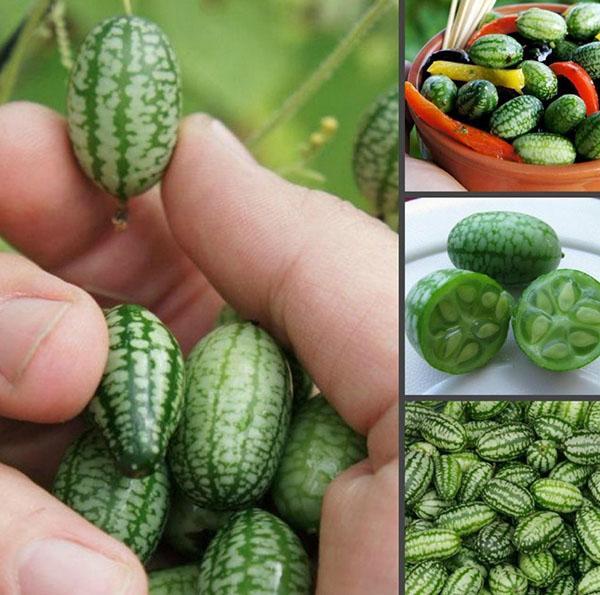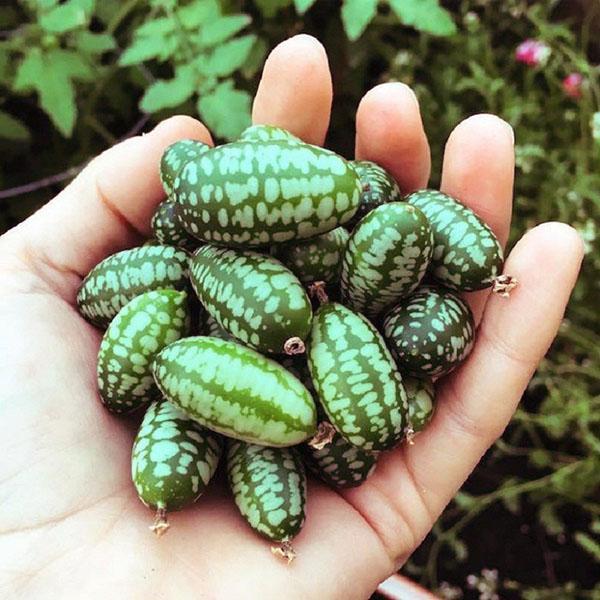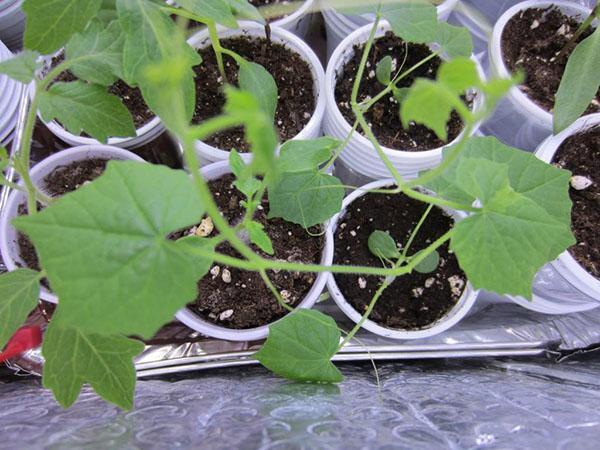Melotria - African mini cucumber with a Russian accent
 Any prepared dish should be not only tasty, but also beautiful. Melotria or an African / Mexican mini cucumber can give it a special charm. Outwardly, it looks like an ordinary watermelon from a bashtan, but only the size of a cherry plum (2-3 cm). The pulp of the fruit resembles a cucumber. Moreover, it has a special acidity, which is given by the tough peel of the berry.
Any prepared dish should be not only tasty, but also beautiful. Melotria or an African / Mexican mini cucumber can give it a special charm. Outwardly, it looks like an ordinary watermelon from a bashtan, but only the size of a cherry plum (2-3 cm). The pulp of the fruit resembles a cucumber. Moreover, it has a special acidity, which is given by the tough peel of the berry.
You can grow this unique mini-watermelon both at home and in the garden. Not only fruits are used for food, but also root crops. To some gourmets, they resemble long radishes both in shape and in taste. It is not recommended to store such an unusual crop, it quickly deteriorates.
Despite the small size of the vegetable, the stem of the plant reaches 3 m in length. From such a weaving bush, you can collect 4-5 kg of an exotic crop.
Amazing melotria: the intricacies of growing African fruit in the "Russian" garden

Next, the landing procedure is carried out:
- 2 seeds are placed in each container, without embedding them in the ground;
- spray abundantly with warm water;
- covered with a plastic bag or cling film;
- put on a window in direct sunlight (content temperature + 25˚C).
 This event is recommended to be carried out in the last days of April in order to transfer the seedlings to the garden by the end of May. If the planting of the melotria mini-cucumber is carried out in the correct way, then the first shoots will appear on the 3rd-6th day. As the soil dries, it is moistened with a spray bottle. After 7 days of such painstaking care, the mini-greenhouse is removed.
This event is recommended to be carried out in the last days of April in order to transfer the seedlings to the garden by the end of May. If the planting of the melotria mini-cucumber is carried out in the correct way, then the first shoots will appear on the 3rd-6th day. As the soil dries, it is moistened with a spray bottle. After 7 days of such painstaking care, the mini-greenhouse is removed.
As soon as the sprouts stretch up to 3-5 cm, they begin to harden. Every day the room is ventilated for 15-20 minutes so that they get used to the fresh air.
 This principle of growing melotria from seeds is also applicable at home. Since the culture does not require large volumes of soil, it is transplanted into a medium-sized pot or shallow box, container. Also, several supports are erected for the plant, otherwise the vine will braid everything that is wrong on its path.
This principle of growing melotria from seeds is also applicable at home. Since the culture does not require large volumes of soil, it is transplanted into a medium-sized pot or shallow box, container. Also, several supports are erected for the plant, otherwise the vine will braid everything that is wrong on its path.
Transplanting Melotria seedlings into open ground
 On the site, a spacious and well-lit place is chosen, but with a slight partial shade. The scorching sun can cause burns on the leaves of the crop. Most gardeners prefer to plant it near the fence, gazebos or wire structures.
On the site, a spacious and well-lit place is chosen, but with a slight partial shade. The scorching sun can cause burns on the leaves of the crop. Most gardeners prefer to plant it near the fence, gazebos or wire structures.
Among other things, the predecessors of the African "guest" in the garden should be:
- legumes;
- tomatoes;
- onions.
Zucchini, cucumbers, eggplants, squash and pumpkin are close relatives of mouse watermelons. Therefore, in the next 4 years, agronomists do not recommend planting a tropical crop after them. Otherwise, all pests and diseases of this family will be inherited by them.
When planting seedlings in open ground, all the rules of agricultural technology are observed. The distance between the bushes should be 45-60 cm. In addition, a trellis or other support is erected 10 cm from each instance.
 Roughly, Melotria transplant is carried out at the end of May. However, it is necessary to take into account the peculiarities of the local climate. The weather should be warm, and the air temperature should be stable, not lower than 10˚C. In some regions, plantings are recommended to be covered with a special protective cloth.It is not worth pinching the shoots, since the plant branches very strongly as it is.
Roughly, Melotria transplant is carried out at the end of May. However, it is necessary to take into account the peculiarities of the local climate. The weather should be warm, and the air temperature should be stable, not lower than 10˚C. In some regions, plantings are recommended to be covered with a special protective cloth.It is not worth pinching the shoots, since the plant branches very strongly as it is.
The leading role of fertilizing and watering
 An exotic crop needs enough water, so the planting is watered abundantly and often. For one copy, according to some studies, add up to 10 liters of liquid. Before water procedures, it is advised to loosen the soil with high quality so that the earth can absorb moisture like a sponge. At the same time, it is important to remove weeds from the garden in time, as well as to feed melotropy.
An exotic crop needs enough water, so the planting is watered abundantly and often. For one copy, according to some studies, add up to 10 liters of liquid. Before water procedures, it is advised to loosen the soil with high quality so that the earth can absorb moisture like a sponge. At the same time, it is important to remove weeds from the garden in time, as well as to feed melotropy.
Fertilizers are applied 2 times per season:
- At the first stage of growing a watermelon cucumber. In the planting, nitrogen-containing mixtures are laid out, which stimulate the growth of green mass.
- During the setting of inflorescences. For their formation, development, as well as further growth, phosphorus and potash fertilizers... Mineral complexes are used every 10 days, until harvest.
To protect vegetation from powdery mildew, it is recommended to spray it with soapy water in July and August. To prepare an improvised fungicide, you will need to dilute 50 g of laundry soap in 10 liters of liquid.
 At home, the rough melotria does not need special care. If it is planted in light, fertile soil with a neutral or slightly acidic reaction, then bountiful harvests can be expected. In such a closed space for the development of full-fledged tubers, the distance between the specimens can be reduced to 15-20 cm. In this case, the grower will have to form the crown of the indoor plant, regularly pruning improperly growing shoots.
At home, the rough melotria does not need special care. If it is planted in light, fertile soil with a neutral or slightly acidic reaction, then bountiful harvests can be expected. In such a closed space for the development of full-fledged tubers, the distance between the specimens can be reduced to 15-20 cm. In this case, the grower will have to form the crown of the indoor plant, regularly pruning improperly growing shoots.
Inflorescences of a mini-cucumber are of 2 types. Males grow in bunches of several yellow flowers. Females are located on the bush separately.
Melotria harvest season in Lilliputian land
 The first striped berries will appear on the vine 2-3 weeks after planting. The farmer will have to collect a miniature crop until the frost. However, in this matter, special punctuality and speed are important, because the African watermelon has a tendency to overripe, like its "Russian relative". For this reason, it is best to pick them slightly immature when they have reached 2 to 3 cm in length.
The first striped berries will appear on the vine 2-3 weeks after planting. The farmer will have to collect a miniature crop until the frost. However, in this matter, special punctuality and speed are important, because the African watermelon has a tendency to overripe, like its "Russian relative". For this reason, it is best to pick them slightly immature when they have reached 2 to 3 cm in length.
 However, growing melotria comes with another surprise. After collecting all the fruits, you can safely dig out the root crop of an exotic culture. From one bush, up to 700 g of a sweet-sour product is obtained, which is eaten raw. Cucumbers can also be grated into a salad or used as vegetable slices.
However, growing melotria comes with another surprise. After collecting all the fruits, you can safely dig out the root crop of an exotic culture. From one bush, up to 700 g of a sweet-sour product is obtained, which is eaten raw. Cucumbers can also be grated into a salad or used as vegetable slices.
Root vegetables should be eaten within 2-3 days after collection. Otherwise, they will lose their elasticity and wither.
Close acquaintance with Melotria rough
 Amazing African cucumbers are rich in fiber as well as minerals. They contain a high percentage of vitamin C, B9 and water. Therefore, they are widely used to combat obesity. The essence of this method of losing weight is the introduction of fasting days (1-2 times a week) based on a cucumber diet. During the day, a woman needs to organize at least 2 meals using only these products.
Amazing African cucumbers are rich in fiber as well as minerals. They contain a high percentage of vitamin C, B9 and water. Therefore, they are widely used to combat obesity. The essence of this method of losing weight is the introduction of fasting days (1-2 times a week) based on a cucumber diet. During the day, a woman needs to organize at least 2 meals using only these products.
Diet salad is prepared according to a simple scheme:
- cut mini-cucumbers into small cubes together with tomatoes;
- season with a little sea salt;
- fill the mass with kefir (0% fat).
As a result, after 3-4 weeks the body will get rid of excess fluid, and the accumulated minerals and vitamins will begin to break down fats. In addition, such a weight loss course is recommended for patients suffering from edema and constipation.
The fruit of the mouse cucumber contains a lot of fiber. Regular consumption of berries helps to remove excess bile from the body, as well as cholesterol. At the same time, the trace elements contained in them prevent the formation of malignant tumors.
 Although many have heard only about the benefits of rough melotria, still harm from it also takes place. The presence of the product in the daily diet leads to an increase in the level of acidity in the stomach.Therefore, people suffering from an ulcer or gastritis need to give it up. In addition, any types of pickles and marinades are contraindicated in atherosclerosis, hypertension, as well as diseases of the heart, liver and kidneys.
Although many have heard only about the benefits of rough melotria, still harm from it also takes place. The presence of the product in the daily diet leads to an increase in the level of acidity in the stomach.Therefore, people suffering from an ulcer or gastritis need to give it up. In addition, any types of pickles and marinades are contraindicated in atherosclerosis, hypertension, as well as diseases of the heart, liver and kidneys.
For cultivation in northern latitudes, the melotria variety Kolibri is recommended. It was launched recently, but it is already enjoying popularity. At the same time, the features of planting and caring for this variety remain unchanged.
 The exotic African watermelon is an unpretentious, high-yielding, and most importantly, an unusually beautiful crop. Therefore, knowing how to properly grow melotria (in a pot or outdoors), the hostess will be able to surprise even gourmets with her dishes.
The exotic African watermelon is an unpretentious, high-yielding, and most importantly, an unusually beautiful crop. Therefore, knowing how to properly grow melotria (in a pot or outdoors), the hostess will be able to surprise even gourmets with her dishes.